Prawn
Dendrobranchiata
Closely related to crabs and lobsters!
Advertisement
Prawn Scientific Classification
- Kingdom
- Animalia
- Phylum
- Arthropoda
- Order
- Decapoda
- Family
- Dendrobranchiata
- Scientific Name
- Dendrobranchiata
Read our Complete Guide to Classification of Animals.
Prawn Conservation Status
Prawn Facts
- Main Prey
- Fish, Insects, Plankton
- Optimum pH Level
- 6.5 - 9.0
- Habitat
- Rocky, coastal waters
- Diet
- Omnivore
- Average Litter Size
- 100
- Favorite Food
- Fish
- Type
- Fresh, Brackish, Salt
- Common Name
- Prawn
- Slogan
- Closely related to crabs and lobsters!
The Southern hemisphere is home to prawns, a crustaceous animal that is in some ways like shrimp. This slightly different fish has a gill structure different than the structure of a shrimp’s body. They are in the same animal family as lobsters and crabs. They live in calm waters, with certain species of them found in the Northern hemisphere.
4 Top Prawn Facts
- Prawn is the name for aquatic crustaceans of a small size
- There are 13 types of prawns
- The female releases eggs in the hundreds of thousands
- They can change color based on where they are
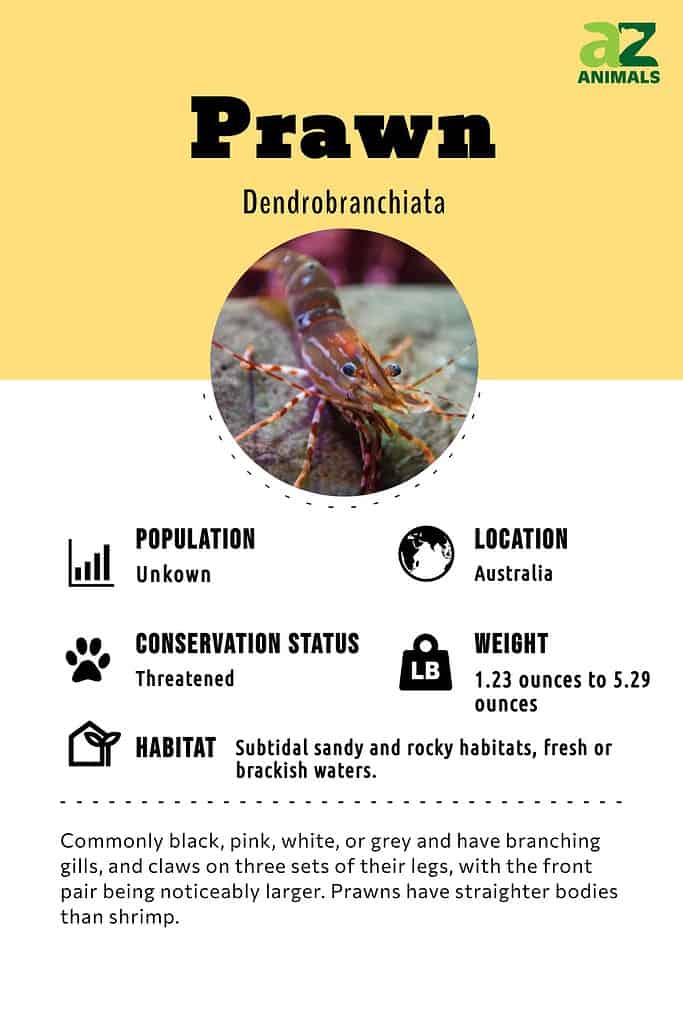
Scientific Name
Though Prawn is the common name for this animal similar to shrimp, its scientific name is Dendrobranchiata and it is part of the crustacea class. It is typically 1 to 1.5 centimeters long. Most of them live their lives in freshwater which helps them thrive.
Evolution And Origin
The fossil of a shrimp-like species known as Kylinxia zhangi, discovered in China, that lived during the Cambrian period, around 518 million years ago, is believed to be the ancient ancestor of the arthropod, which includes the prawn. Kylinxia zhangi was a very rare species and exhibited the distinct features present in true arthropods.
Types Of
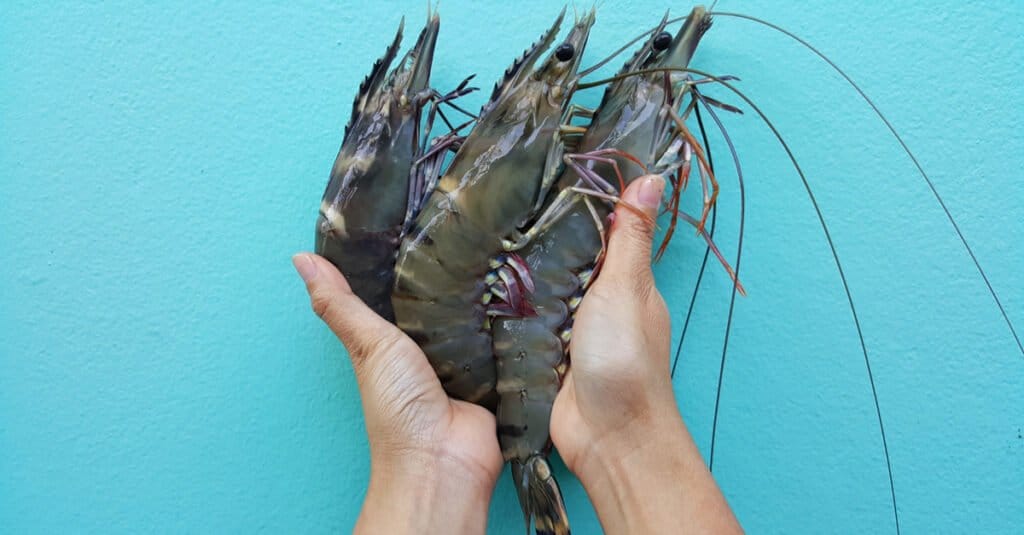
There are 200 subspecies of prawns.
©Koy_Hipster/Shutterstock.com
In total, there are 200 subspecies of prawns. One of the first subspecies of this crustacean discovered by scientists was the giant river prawn. The scientific name of this subspecies is Machrobachium rosenbergii. It lives in subtropical and tropical water. Machrobachium rosenbergii are found throughout the Indo-Pacific Region. Though the majority of these subspecies are found in freshwater, some live in the mouths of rivers where the water is salty.
The Palaemon, also known as the common prawn, lives in the waters of Pakistan, India, and Bangladesh in ponds, rivers, and streams. The Melicertus kerathurus, or caramote prawn, is found in the Mediterranean Sea and the eastern Atlantic Ocean. The Indian prawn, (Fenneropenaeus indicus), is one of the largest commercial species of prawn.
The word prawn dates back to 15th-century England. At that time, the animal was referred to as prane, prayne, or praine. Today, the word prawn is most often heard in Ireland and the United Kingdom.
Appearance And Behavior
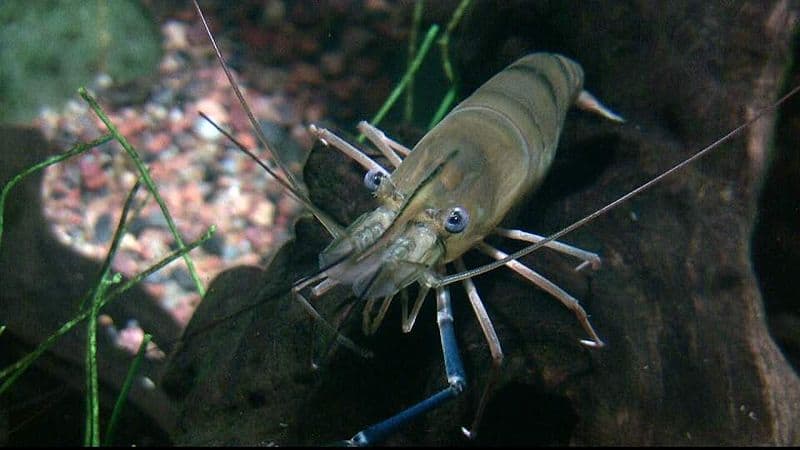
Under the right circumstances, a prawn can change colors.
©Syrist / Creative Commons – Original
Prawns are commonly black, pink, white, or grey. When a Palaemon is fully grown it is generally between six and eight inches long, or the size of a GI Joe action figure. Upon being caught, the fish is a pale blue. It has a cylindrical and elongated body. From one side to the other, their body is compressed a little bit.
A Palaemon has two parts to their bodies. One part is anterior and one is posterior. Its cephalothorax is un-jointed. This means that they have six pairs of appendages, which is any part of the body that is attached to its main part, and those parts have no joints, like what humans have in their knees to help them bend.
The posterior of a Palaemon prawn has an abdomen that is jointed, the exact opposite of its anterior. The abdomen sticks out over the rest of the invertebrate’s body. Their abdomen has six different segments. All six segments have their own set of appendages. The appendages are located on the ventral surface. This is the lower part of their body. On a human being, it would be where the liver is located.
One part of the abdomen is on the inside of the prawn’s body and one is on the outside. On the outside is a telson. The telson is located on its tail. At the other end of the abdomen is the cephalothorax. This is where the head meets its thorax. The thorax is surrounded by the abdomen and the neck. At the bottom of the body, it has thirteen pairs of appendages.
In 2014 fishermen off the coast of Florida found a record-breaking 18-inch long prawn, making it the largest ever caught and recorded.
It is common to find this large invertebrate by itself. King Prawns avoid exposure to light because they are sensitive to it. However, Tiger Prawns are active all the time. When it comes to Freshwater Prawns, they are the happiest living in shallow water with access to mud.
Under the right circumstances, a prawn can change colors. They can do this because of the pigment in their skin, located directly under their shell. The cells in their skin allow them to become blue, yellow, red, yellow-white, and sepia-brown. The color they turn is determined by how many of that color’s cells are in their bodies. The cells give school prawns pale spots, while deepwater prawns become bright red or even scarlet.
Deepwater prawns turn bright red because of where they are in the water. Color can’t be seen, so they appear black. This makes it harder for predators to spot them.
Habitat
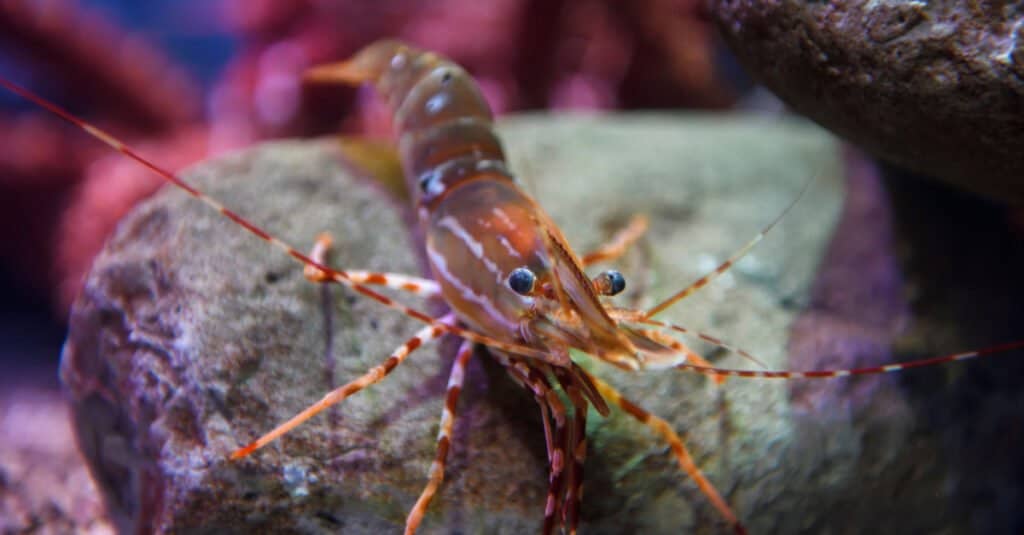
Prawns are found in the northern regions of Australia.
©Reimar/Shutterstock.com
Northern regions of Australia are the homes of bananas, brown tigers, and western king prawns. They are larger in these regions than in other parts of the world and choose to live in coastal waters near the shore. Banana prawns are also frequently found in Exmouth, which is a town in England. Tiger Prawns live in Shark Bay. Along Western Australia’s coast, it is easy to find King Prawns. They can also be found in the country’s Swan River.
What Do They Eat?
As an omnivorous animal, this large crustacean commonly eats plankton and carrion, which are microorganisms. They also eat the smallest worms, shellfish, and any organic matter that is decayed.
When a prawn is first born they eat small pieces of marine plants and seaweed. When they are about one year old, they can expand their diet. Adults are scavengers who will eat what they can find. Their diet often includes dead fish, sand, crabs, and mud. Unlike other animals in the sea, they have no problem eating each other and most commonly do this if they can’t find other sources of food.
Prawns that live in cold water avoid eating sand or mud. This means that king and tiger prawns have veins that look contrasting from their cold-water counterparts. Since cold water prawns don’t eat sand or mud and Tiger & King Prawns do, the cold water prawns have clear veins in their bodies.
Predators And Threats
Both young and adult prawns are the victims of predators. Though they can be victims at any time, they are the most vulnerable when they are in the larval period of their development. At that time they are often killed by bottom-dwelling fish such as squid and cuttlefish.
Reproduction, Babies, And Life Span
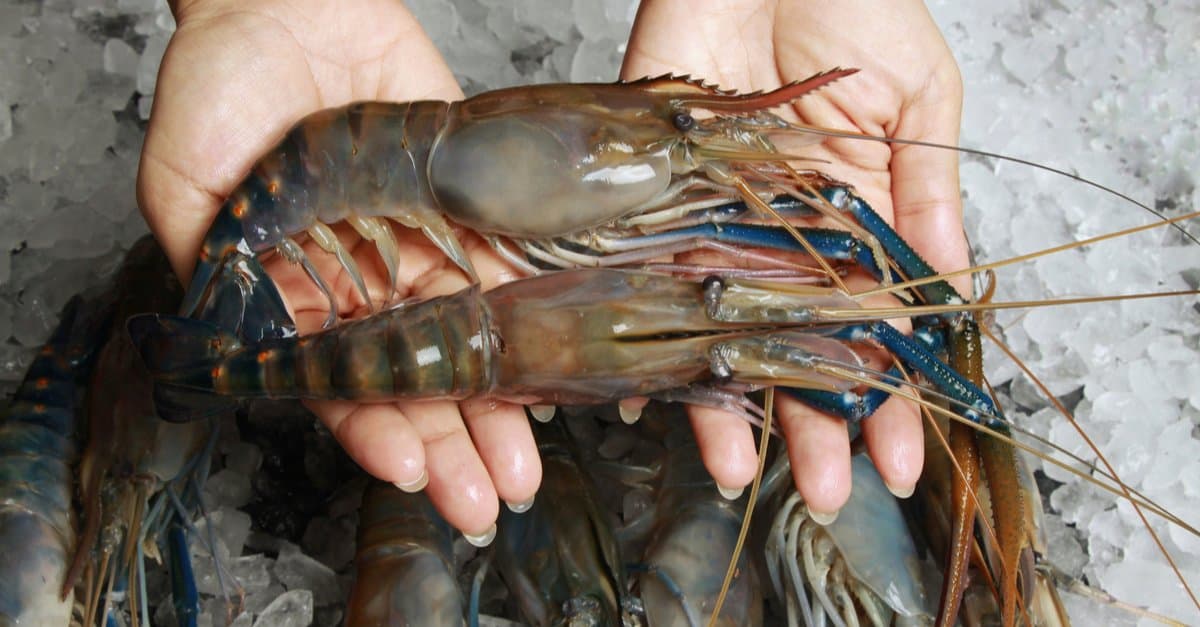
Female prawns are larger than the male prawns.
©YodJedsada/Shutterstock.com
A grown female is larger than a grown male of the species. It is easy to tell if they are male or female. A male has an organ called a pestana between their legs. A female has a thelycum, which is what lets them mate with males.
Adult female prawns have visible ovaries. They are located on her head and her tail. Before ovaries mature they are pale yellow or olive. After their ovaries mature they become an orange-brown color. In order for a pair of prawns to reproduce, the male’s shell must be hard and the female’s shell must be soft.
Eggs are fertilized while still inside a female body. It is believed that spawning takes place right after the eggs have been fertilized. Females can get pregnant multiple times during the mating season. Different sizes and species of females are capable of carrying a different number of eggs. How frequently they spawn has to do with where they live. In Queensland, Australia, easter King Pawns can spawn at any time of the year. King Prawns living anywhere else will not spawn during the winter months.
There are three types of life cycles they follow and each one varies. Those types are Estuarine, Marine, and Mixed. In seawater, the Estuarine life cycle is completed. One subspecies that lives this life cycle is the greasy back prawn, Metapenaeus bennettae. In ocean waters, royal red prawns live the marine life cycle.
The mixed life cycle is different because it is the life cycle that baby prawns follow. During this life cycle, females shed their fertilized eggs at the bottom of the ocean. The eggs remain on the ocean floor until the babies are ready to be born. Babies live this cycle until they become adults. The mixed life cycle takes place over a period of two to three weeks.
Overall, the life cycle for this creature is a brief one. School prawns live an average of one year. Eastern King and other larger prawns can live to be two years old. In some cases, they may even live for three years.
Prawn FAQs (Frequently Asked Questions)
What Are Prawns And What Is the Difference Between A Prawn And A Shrimp?
Many people are confused about the differences between prawns and shrimps. Though in some parts of the word, people consider them to be the same animal, they are not. The things they have in common include the fact that they both have an exoskeleton and 10 legs. They also look similar and both live close to the floor of the ocean.
Both the pawn and the shrimp live in freshwater and saltwater. However, prawns mainly stick to freshwater. Shrimp mainly stick to saltwater. Other differences include the fact that their gills are shaped differently. While the body of a shrimp is slightly curled, the body of a prawn is completely straight.
It is easy to tell the difference between a shrimp and a prawn by looking at their legs. A shrimp’s front legs are the largest they have. The second pair of legs on a prawn is its biggest. Prawns have three pairs of legs with claws on them. Another difference is that while prawns let their fertilized eggs grow in the water, shrimp carry their eggs under their bodies until the babies are born.
Are Prawns herbivores, carnivores, or omnivores?
Prawns are Omnivores, meaning they eat both plants and other animals.
What Kingdom do Prawns belong to?
Prawns belong to the Kingdom Animalia.
What phylum do Prawns belong to?
Prawns belong to the phylum Arthropoda.
What family do Prawns belong to?
Prawns belong to the family Dendrobranchiata.
What order do Prawns belong to?
Prawns belong to the order Decapoda.
What type of covering do Prawns have?
Prawns are covered in Shells.
In what type of habitat do Prawns live?
Prawns live in rocky, coastal waters.
What do Prawns eat?
Prawns eat fish, insects, and plankton.
What are some predators of Prawns?
Predators of Prawns include humans, fish, and squid.
What is the average litter size for a Prawn?
The average litter size for a Prawn is 100.
What is an interesting fact about Prawns?
Prawns are closely related to crabs and lobsters!
What is the scientific name for the Prawn?
The scientific name for the Prawn is Dendrobranchiata.
What is the lifespan of a Prawn?
Prawns can live for 2 to 4 years.
What is the optimal pH for a Prawn?
The optimal pH for a Prawn is between 6.5 and 9.0.
What are the differences between a prawn and a crawfish?
The key differences between a prawn and a crawfish are appearance, habitat, and diet.
Thank you for reading! Have some feedback for us? Contact the AZ Animals editorial team.
Sources
- David Burnie, Dorling Kindersley (2011) Animal, The Definitive Visual Guide To The World's Wildlife / Accessed December 16, 2008
- Tom Jackson, Lorenz Books (2007) The World Encyclopedia Of Animals / Accessed December 16, 2008
- David Burnie, Kingfisher (2011) The Kingfisher Animal Encyclopedia / Accessed December 16, 2008
- Richard Mackay, University of California Press (2009) The Atlas Of Endangered Species / Accessed December 16, 2008
- David Burnie, Dorling Kindersley (2008) Illustrated Encyclopedia Of Animals / Accessed December 16, 2008
- Dorling Kindersley (2006) Dorling Kindersley Encyclopedia Of Animals / Accessed December 16, 2008
- Chinese Academy of Sciences / Published November 5, 2020 / Accessed March 30, 2023


















